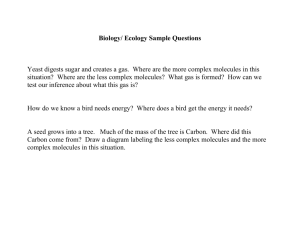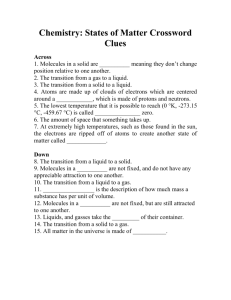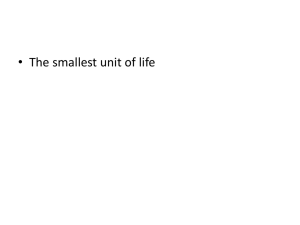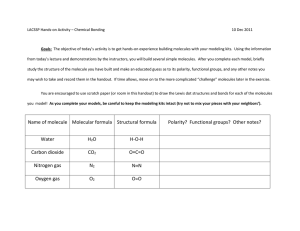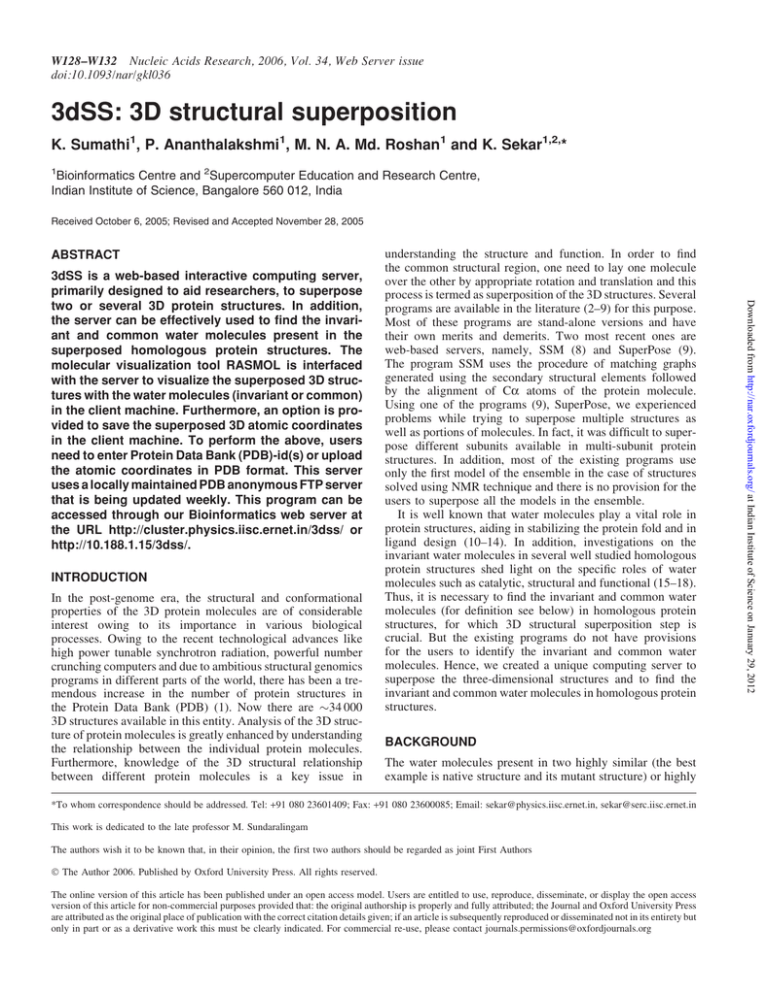
W128–W132 Nucleic Acids Research, 2006, Vol. 34, Web Server issue
doi:10.1093/nar/gkl036
3dSS: 3D structural superposition
K. Sumathi1, P. Ananthalakshmi1, M. N. A. Md. Roshan1 and K. Sekar1,2,*
1
Bioinformatics Centre and 2Supercomputer Education and Research Centre,
Indian Institute of Science, Bangalore 560 012, India
Received October 6, 2005; Revised and Accepted November 28, 2005
ABSTRACT
INTRODUCTION
In the post-genome era, the structural and conformational
properties of the 3D protein molecules are of considerable
interest owing to its importance in various biological
processes. Owing to the recent technological advances like
high power tunable synchrotron radiation, powerful number
crunching computers and due to ambitious structural genomics
programs in different parts of the world, there has been a tremendous increase in the number of protein structures in
the Protein Data Bank (PDB) (1). Now there are 34 000
3D structures available in this entity. Analysis of the 3D structure of protein molecules is greatly enhanced by understanding
the relationship between the individual protein molecules.
Furthermore, knowledge of the 3D structural relationship
between different protein molecules is a key issue in
BACKGROUND
The water molecules present in two highly similar (the best
example is native structure and its mutant structure) or highly
*To whom correspondence should be addressed. Tel: +91 080 23601409; Fax: +91 080 23600085; Email: sekar@physics.iisc.ernet.in, sekar@serc.iisc.ernet.in
This work is dedicated to the late professor M. Sundaralingam
The authors wish it to be known that, in their opinion, the first two authors should be regarded as joint First Authors
The Author 2006. Published by Oxford University Press. All rights reserved.
The online version of this article has been published under an open access model. Users are entitled to use, reproduce, disseminate, or display the open access
version of this article for non-commercial purposes provided that: the original authorship is properly and fully attributed; the Journal and Oxford University Press
are attributed as the original place of publication with the correct citation details given; if an article is subsequently reproduced or disseminated not in its entirety but
only in part or as a derivative work this must be clearly indicated. For commercial re-use, please contact journals.permissions@oxfordjournals.org
Downloaded from http://nar.oxfordjournals.org/ at Indian Institute of Science on January 29, 2012
3dSS is a web-based interactive computing server,
primarily designed to aid researchers, to superpose
two or several 3D protein structures. In addition,
the server can be effectively used to find the invariant and common water molecules present in the
superposed homologous protein structures. The
molecular visualization tool RASMOL is interfaced
with the server to visualize the superposed 3D structures with the water molecules (invariant or common)
in the client machine. Furthermore, an option is provided to save the superposed 3D atomic coordinates
in the client machine. To perform the above, users
need to enter Protein Data Bank (PDB)-id(s) or upload
the atomic coordinates in PDB format. This server
uses a locally maintained PDB anonymous FTP server
that is being updated weekly. This program can be
accessed through our Bioinformatics web server at
the URL http://cluster.physics.iisc.ernet.in/3dss/ or
http://10.188.1.15/3dss/.
understanding the structure and function. In order to find
the common structural region, one need to lay one molecule
over the other by appropriate rotation and translation and this
process is termed as superposition of the 3D structures. Several
programs are available in the literature (2–9) for this purpose.
Most of these programs are stand-alone versions and have
their own merits and demerits. Two most recent ones are
web-based servers, namely, SSM (8) and SuperPose (9).
The program SSM uses the procedure of matching graphs
generated using the secondary structural elements followed
by the alignment of Ca atoms of the protein molecule.
Using one of the programs (9), SuperPose, we experienced
problems while trying to superpose multiple structures as
well as portions of molecules. In fact, it was difficult to superpose different subunits available in multi-subunit protein
structures. In addition, most of the existing programs use
only the first model of the ensemble in the case of structures
solved using NMR technique and there is no provision for the
users to superpose all the models in the ensemble.
It is well known that water molecules play a vital role in
protein structures, aiding in stabilizing the protein fold and in
ligand design (10–14). In addition, investigations on the
invariant water molecules in several well studied homologous
protein structures shed light on the specific roles of water
molecules such as catalytic, structural and functional (15–18).
Thus, it is necessary to find the invariant and common water
molecules (for definition see below) in homologous protein
structures, for which 3D structural superposition step is
crucial. But the existing programs do not have provisions
for the users to identify the invariant and common water
molecules. Hence, we created a unique computing server to
superpose the three-dimensional structures and to find the
invariant and common water molecules in homologous protein
structures.
Nucleic Acids Research, 2006, Vol. 34, Web Server issue
DATA PRESENTATION AND AVAILABILITY
The software is developed and optimized for Intel based
Solaris (Version 10.0) and is driven by 3.0 GHz pentium IV
processor equipped with 2 GB RD RAM. This operating
system is chosen for better security, scalability and reliability.
The software and its functionalities are well tested on
Windows 95/98/2000, Linux and SGI platforms. During validation of the software, we realized that two web browsers,
namely, NETSCAPE (version 4.7 and 7.2) and MOZILLA
behaved well. To visualize the superposed 3D structures in
the client machine, user needs to interface the molecular visualization tool RASMOL (only for the first time usage of the
software) and the necessary instructions are provided in the
link (http://cluster.physics.iisc.ernet.in/3dss/rasmol.html). The
following are the four major options provided in the proposed
computing server.
(a)
(b)
(c)
(d)
Superpose only two structures,
Superpose several structures,
Superpose subunits within a structure, and
Superpose different models present in NMR ensemble.
All the above options, allow users to select the structures
available in the PDB by providing its unique PDB-id or by
up-loading the 3D atomic coordinates (PDB format) from the
local hard disk of the client machine. Once the file is uploaded,
the program automatically culls the input PDB file and displays all the chain details of the structure in a convenient
form. Using the check box, users can select the entire file,
a particular chain or a portion of the chain(s) for superposition. For the option (b), firstly the user needs to provide the
number of molecules to be superposed on the fixed molecule.
Figure 1. The screen snapshot shows the superposition of 12 structures of recombinant phospholipase A2. The top panel shows the status of superposition and the
right RASMOL graphics panel displays the superposition in different colors (see the last column of the top panel for coloring scheme). The bottom left panel shows the
graphical display of the r.m.s.d. values of the 12 structures and is generated using the data display engine, Ploticus. It is clear from the plot that the region 60–70 is
having large deviations compared with the remaining portion of the molecule.
Downloaded from http://nar.oxfordjournals.org/ at Indian Institute of Science on January 29, 2012
homologous structures (the inhibitor free and inhibitor bound
structure) are known as invariant water molecules. Further,
such situation is also possible in multi-subunit protein structures. For example, if a molecule has four identical subunits,
the water molecules that interact with the residues in the same
position in different subunits (e.g. subunit A and B) can be
considered as invariant water molecules. On the other hand,
common water molecules are those, which lie at the interface
and interact with the selected subunits.
In the computing server, two widely recognized programs
STAMP (19) and ProFit (A. C. R. Martin, http://www.bioinf.
org.uk/software/profit/) are deployed for superposition
purposes. The program STAMP uses multiple sequence alignment using the amino acid sequence information followed by
an initial superposition of structures. In contrast, the program
ProFit uses the McLachlan fitting algorithm, essentially a
steepest descent minimization (3). The user-friendly molecular visualization tool RASMOL (20) is interfaced to view the
superposed molecules in the client machine. This server is
developed using PERL, HTML and JAVASCRIPT. Ploticus
[Copy right 1998–2002, Stephan C. Grugg (scg@jax.org)],
a data display engine is used for generating plots to display
root mean square deviation (r.m.s.d.) graphically.
W129
W130
Nucleic Acids Research, 2006, Vol. 34, Web Server issue
Based on this number, provisions will be available to the
user to either supply the PDB-id’s or upload the 3D atomic
coordinates from the client machine. By default, the server
produces only the structural superposition output. It is worth
mentioning that necessary check boxes are provided in the
options (a) and (b) to find the invariant water molecules
present in the structures. Owing to computational complexity,
the number of structures to be superposed on the fixed
molecule is limited to 20 at any given time. For option (c),
the molecule needs to contain more than one copy of the same
polypeptide chain. Using this option, the users can perform
three different calculations: (i) superpose different subunits
present in a selected structure, (ii) superpose and identify
the invariant water molecules and (iii) identify the common
water molecules. The option (d) performs structural superposition of various models present in a NMR ensemble
and the user can select the models of interest. Here again,
the number of mobile molecules is limited to 20 for superposition. In the first three major options, the server displays all
models of NMR structure so that the users can select any
particular model using the pull-down menu. As mentioned
above, two superposition programs (STAMP and ProFit)
are deployed for structural superposition and the user has
the freedom to choose a program of interest. A detailed output
containing r.m.s.d. values, sequence identity, rotation matrix,
translation vector and so on will be displayed. Most importantly, users can save the superposed atomic coordinates in
the local client machine for further analysis. The users of
the program are requested to cite this article and the URL
address in their research proceedings.
CASE STUDY
The output of a typical superposition of 12 (native, mutants
and inhibitor complexes) structures of recombinant phospholipase A2 (21–23) (1VL9, 1UNE, 1MKS, 1FDK, 1MKV,
1MKT, 1KVX, 1O2E, 1VKQ, 1IRB, 1GH4 and 1C74 solved
using X-ray crystallography is shown in Figure 1. The PDB-id
1VL9 is used as a fixed molecule and the remaining 11 structures are treated as mobile molecules (molecules to be superposed on the fixed molecule). The program STAMP is used
for superposition. The top panel shows a detailed output like
status of superposition, sequence identity, stamp score and
r.m.s.d. values. The RASMOL graphics panel on the right
shows the superposition of all the structures in different colors.
Figure 2 displays the invariant water molecules in six different
crystal structures of Oligo-peptide binding proteins (OppA)
(24). The structure (1B4Z {457}) is used as fixed molecule and
the remaining five (1B32 {437}, 1B3F {455}, 1B3G {356},
1B46 {374} and 1B51 {433}) are treated as mobile molecules.
The number within braces represents the number of water
molecules present in the 3D structures. The server reports
209 invariant water molecules in all the structures. It is interesting to note that 58.7% (209/356) of the water molecules is
invariant. The invariant water molecules are identified after
superposition within a distance of 1.8 s (between the water
molecules). Figure 3 shows the invariant water molecules
between different subunits of a tetramer. The PDB-id used
here is 1JAC (25) and it has eight different chains [four
heavy chains (A, C, E, G) and four light chains (B, D,
F, H)]. The superposition of different chains A, B, C, D
(green) and E, F, G, H (red) along with 36 invariant water
Downloaded from http://nar.oxfordjournals.org/ at Indian Institute of Science on January 29, 2012
Figure 2. The screen shot displays the superposition of six OppA along with 209 invariant water molecules. This is carried out using the option (b), ‘Superpose
several structures’ and ‘Superpose and identify invariant water molecules’.
Nucleic Acids Research, 2006, Vol. 34, Web Server issue
W131
Figure 4. The output shows the common water molecules between the subunits A and B. The RASMOL panel shows eight common water molecules (blue color).
This is carried out using the option (c) ‘Superpose subunits within a structure and ‘identify common water molecules’.
Downloaded from http://nar.oxfordjournals.org/ at Indian Institute of Science on January 29, 2012
Figure 3. The output panel depicts the superposition of eight different chains along with 36 invariant water molecules in PDB-id: 1JAC. The chains A, B, C, D (fixed)
are colored green and the color red is used for the chains E, F, G, H (mobile). The invariant water molecules are having the same color as the corresponding subunits.
W132
Nucleic Acids Research, 2006, Vol. 34, Web Server issue
molecules and their interactions with the subunits are shown.
The calculation is performed using the options ‘Superpose
subunits within a structure’ and ‘identify invariant water
molecules’. The common water molecules between two different subunits (only subunit A and B are used) of a tetrameric
protein [PDB-id 1J4S (26)] are shown in Figure 4. Here, the
options (c), ‘Superpose subunits within a structure’ and
‘Identify common water molecules’ are used. The subunits
A and B are shown in green and red colors, respectively.
There are eight water molecules (blue), which are common
between the chains A and B.
CONCLUSIONS
ACKNOWLEDGEMENTS
The corresponding author (K.S.) thanks Dr Geoffrey Barton
and Dr Andrew Martin for permitting to use their superposition
programs in the computing server. The authors thank
Ch. Kiran Kumar for his help at the initial stages of this
work. One of the authors (K.S.) thanks Ms P. Mridula for
critical manuscript reading. The proposed search engine is
developed and maintained at the Bionformatics Centre,
Indian Institute of Science, Bangalore 560 012, India. All
the contributing authors acknowledge the use of the facilities:
the Interactive Graphics Based Molecular Modeling, Bioinformatics centre and the Supercomputer Education and
Research Centre. The first two facilities are supported by the
Department of Biotechnology (DBT), Government of India.
We are grateful for the individual (K.S.) project support
from DBT. A part of this work is supported by the Institute
wide Computational Genomics Program. The Open Access
publication charges for this article were waived by Oxford
University Press.
Conflict of interest statement. None declared.
REFERENCES
1. Bernstein,F.C., Koetzle,T.F., Williams,G.J.B., Meyer,E.F.Jr, Brice,M.D.,
Rogers,J.R., Kennard,O., Shimanouchi,T. and Tasumi,M.J. (1977) The
Protein Data Bank: a computer based archival file for macromolecular
structures. J. Mol. Biol., 112, 535–542.
2. Kabsch,W.A. (1978) Discussion of solution for best rotation of two
vectors. Acta Crystallogr., A34, 827–828.
3. MacLachlan,A.D. (1982) Rapid comparison of protein structures.
Acta Crystallogr., A38, 871–873.
Downloaded from http://nar.oxfordjournals.org/ at Indian Institute of Science on January 29, 2012
At the outset, 3dSS is created to better serve the research
community working in the area of structural bioinformatics.
This computing server is very useful to superpose either
complete or partial structures. Furthermore, the server can
effectively be used to identify the invariant and common
water molecules. The knowledge base (PDB) used by the
server is up-to-date and hence the user will be able to access
the latest information available in the PDB. As described, it
is tempting to conclude that the software will certainly be
beneficial for many macromolecular crystallographers and
the undergraduate/graduate students working in the area of
structural bioinformatics.
4. Kearsley,S.K. (1990) An algorithm for the simultaneous superposition of
a structural series. J. Comput. Chem., 11, 1187–1192.
5. Diamond,R. (1992) On the multiple simultaneous superposition of
molecular structures by rigid body transformations. Protein Sci., 1,
1279–1287.
6. Koradi,R., Billeter,M. and Wuthrich,K. (1996) MOLMOL: a program for
display and analysis of macromolecular structures. J. Mol. Graph., 14,
29–32.
7. Kaplan,W. and Littlejohn,T.G. (2001) SWISS-PDB Viewer (Deep View).
Brief. Bioinformatics, 2, 195–197.
8. Krissinel,E. and Henrick,K. (2004) Secondary-structure matching (SSM),
a new tool for fast protein structure alignment in three dimensions.
Acta Crystallogr., D60, 2256–2268.
9. Maiti,R., Domselaar,G.H.V., Zhang,H. and Wishart,D.S. (2004)
SuperPose: a simple server for sophisticated structural superposition.
Nucleic Acids Res., 32, W590–W594.
10. Kuntz,I.D. and Kauzmann,W. (1974) Hydration of proteins and
polypeptides. Adv. Protein Chem., 28, 239–345.
11. Eisenberg,D. and McLachlan,A.D. (1986) Solvation energy in protein
folding and binding. Nature, 319, 199–203.
12. Sanschagrin,P.A. and Kuhn,L.A. (1998) Cluster analysis of consensus
water sites in thrombin and trypsin shows conservation between
serine proteases and contributions to ligand specificity. Protein Sci.,
7, 2054–2064.
13. Sundaralingam,M. and Shekarudu,Y.C. (1989) Water-inserted
alpha-helical segments implicate reverse turns as folding intermediates.
Science, 244, 1333–1337.
14. Sessions,R.B., Thomas,G.L. and Parker,M.J. (2004) Water as
a conformational editor in protein folding. J. Mol. Biol., 343, 1125–1133.
15. Biswal,B.K., Sukumar,N. and Vijayan,M. (2000) Hydration, mobility
and accessibility of lysozyme: Structures of a pH 6.5 orthorhombic
form and its low humidity variant and a comparative study involving
20 crystallographically independent molecules. Acta Crystallogr.,
D56, 1110–1119.
16. Zhang,X.-J. and Matthews,B.W. (1994) Conservation of solvent-binding
sites in 10 crystal forms of T4 Lysozyme. Protein Sci., 3,
1031–1039.
17. Prasad,B.V.L.S. and Suguna,K. (2002) Role of water molecules in the
structure and function of aspartic proteinases. Acta Crystallogr.,
D58, 250–259.
18. Kishan,K.V.R., Chandra,N.R., Sudarsanakumar,C., Suguna,K. and
Vijayan,M. (1995) Water-dependent domain motion and flexibility in its
ribonuclease A and the invariant features in its hydration shell. An X-ray
study of two low-humidity crystal forms of the enzyme. Acta Crystallogr.,
D51, 703–710.
19. Russell,R.B. and Barton,G.J. (1992) STAMP: multiple protein sequence
alignment from tertiary structure comparison. Proteins, 14, 309–323.
20. Sayle,R.A. and Milner-Whilte,E.J. (1995) RASMOL: Biomolecular
graphics for all. Trends Biochem. Sci., 20, 374–382.
21. Sekar,K. and Sundaralingam,M. (1999) High resolution refinement of the
orthorhombic form of bovine pancreatic phospholipase A2. Acta
Crystallogr., D55, 46–50.
22. Sekar,K., Rajakannan,V., Gayathri,D., Velmurugan,D., Poi,M.-J.,
Dauter,M., Dauter,Z. and Tsai,M.-D. (2005) Atomic resolution (0.97 s)
structure of the triple mutant (K53,56,121M) of bovine pancreatic
phospholipase A2. Acta Crystallogr., F61, 3–7.
23. Sekar,K., Eswaramoorthy,S., Jain,M.K. and Sundaralingam,M. (1997)
Crystal structure of the complex of bovine pancreatic phospholipase A2
with the inhibitor 1-hexadecyl-3-(trifluoroethyl)-sn-glycero-2phosphomethanol. Biochemistry, 36, 14186–14191.
24. Tame,J.R., Murshudov,G.N., Dodson,E.J., Neil,T.K., Dodson,G.G.,
Higgins,C.F. and Wilkinson,A.J. (1994) The structural basis of
sequence-independent peptide by OppA protein. Science,
264, 1578–1581.
25. Sankaranarayanan,R., Sekar,K., Banerjee,R., Sharma,V., Surolia,A. and
Vijayan,M. (1996) A novel mode of carbohydrate recognition in Jacalin,
a moracea plant lectin with a beta-prism fold. Nature Struct. Biol., 3,
596–602.
26. Pratap,J.V., Prakash,A.A., Rani,P.G., Sekar,K., Surolia,A. and
Vijayan,M. (2002) Crystal structures of Artocarpin, a moracea Lectin
with mannose specificity and its complex with methyl-alpha-D-Mannose:
implications to the generation of carbohydrate specificity.
J. Mol. Biol., 317, 237–247.

